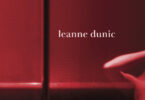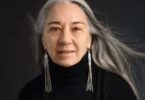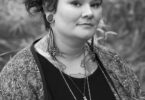Interview by Rachna Contractor
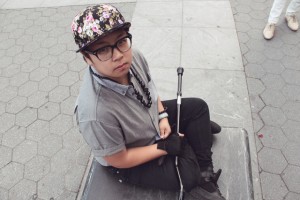 Kay Ulanday Barrett is a poet, performer, and educator who draws from his experience as a “disabled, pin@y-amerikan transgender queer in the US” to create art about community, culture, food, struggle, and resistance. He performs on campuses throughout the United States and Canada.
Kay Ulanday Barrett is a poet, performer, and educator who draws from his experience as a “disabled, pin@y-amerikan transgender queer in the US” to create art about community, culture, food, struggle, and resistance. He performs on campuses throughout the United States and Canada.
What is your preferred pronoun?
My pronouns are he, they, my name K., and siya (Tagalog for they/them).
You write a lot about food and its role in community and culture. What’s your favourite cuisine and dish?
I love that this is the first question because I be thinking about it all the damn time! My current favourite foods have everything to do with fresh herbs like basil and mint, very Southeast Asian flavours balanced with herbaceous bright ingredients. I’ve been known to have a penchant for leafy greens that are tossed into garlicky fried rice, coconut milk rice; I honestly am a diasporic pin@y cook and eater, so my belly reflects that. Throughout my life, food hasn’t always been within reach whether it’s been due to chronic poverty or living in food deserts. I’m now compelled to find cheap, delicious food for myself and my loved ones. Today I am in Oakland eating fresh spring rolls with shrimp from Champa Garden near Lake Merritt. Earlier, I was chomping on crispy adobo noodles from Kainbigan, a Filipina queer–owned resto also in Oakland.
What happened to your blog, Recipes for the People?
RFP is my biggest wish and dream project. I had the brilliant honour to connect with some of my favourite artists, all of whom are Queer, Transgender People of Colour (QTPOC), many of whom have diasporic lives. It was a survival project, really. I was in a hard time during my twenties (Oh! Saturn’s Return!) so I sought out people whose coping and healing reverted to the love of food. I wanted deliberate storytelling involved in the project, so I interviewed a range of QTPOC who explored their family’s recipes, their best or worst food memories, and showcased “fierce foodies.” The best part of the “fierce foodies” segment always came when artists, poets, painters, farmers, educators, and cultural workers got to share their recipes. One genius visual artist shared her work via drawings, another person elaborated via mixed tape on their mango chicken recipe. RFP didn’t pay. I had to focus on other projects. RFP is still in the process of [producing] a documentary connecting food justice, cultural work, and QTPOC. I wanted to address gaps in food justice that didn’t consider the disabled, the queer, the children of migrants, the brown kids, and the socially anxious. We have something to contribute when it comes to the daily and spiritual act of nourishment. We have hang-ups from missing our homelands, so here is this yam dessert we remember from watching our lolas. We have places where the only solace is the legit stew we learned from a lover or a kindred queer soul whom we’ve lost. There are memories in food that bring us back to where we belong. RFP helped bring belonging and I don’t think it’ll ever die.
Poetry is a chosen art form for many activists; it’s powerful, it’s performative, and it has both audio and visual qualities. How did you and poetry find each other? When did you start writing and performing poetry?
When I was seven years old, my mama gave me a journal, my very first diary. It had pink ballet toe shoes and a locket and the paper was as thick as fingernails. The paper was lined, I remember. I had no siblings, was hard up on making friends, I was picked on all the time, a big-mouthed poor brown genderqueer kid and hence, a perfect target for pummelling. Some children have imaginary friends growing up; I had my diary. I wrote at a young age, a dorky kid with big-ass glasses in Midwestern Amerika and so it went, all the observations.
As a teenager, I found poetry in the nineties in Chicago, during a pivotal time of spoken word and slam poetry. Asian American spoken word was elevated then, it was a movement, and so groups like I Was Born with 2 Tongues and Mango Tribe engaged me. I was encouraged to write. I was encouraged to perform, to be in community. They were inseparable. I wanted queer & transgender voices so I worked with cultural organizations with queer people of colour and found poets in the states I had major poetic crushes on. I tried to write and conspire with them as often as possible. I was extremely fortunate that people were kind to me, mentored me; some of my favourite poets are inextricably with me, in the stanzas I still write. It’s our QTPOC imprint to do this together. We are not alone, we didn’t create this brown and out existence from a vacuum. There were people that came before me that made my stage banter possible and my upcoming book possible. I carry that lineage as I continue to make this life of poetry something till I die. I am here fifteen years later, blessed to tour with the queerest and kindest peoples there are, making poems into praxis. I am addicted both to performing poetry and to the solitary act of writing. I am ever in crush mode with people’s words. I am continuously craving maps that decolonize bullshit in the most pretty and humble ways as possible.
Which poets and writers most influence you?
Shout-out to queer women of colour writers like Sharon Bridgforth, Lani Montreal, and Leah Lakshmi Piepzna-Samarasinha, who taught me to write with the sharpest craft, craft that needs your people, needs justice and truth-telling made priority in every line. Without their work, I think I would just be a mess, a sad and stranded mess. Now, I am a mess with purpose. The writing and performance work of Sins Invalid, co-founded by Patricia Berne & Leroy Moore, has compelled me to connect deeper into my understandings of disability and desire. Lately, I am excited about an anthology I’m contributing to entitled Writing the Walls Down: A Convergence of LGBTQ Voices, edited by Amir Rabiyah & Helen Klonaris. I’ve forever adored Amir’s work and the ways he explores his brown transmasculinity through writing. It’s a dreamy thing to be a part of one of his projects!
When you write, do you think about how the piece lives on the page or in performance?
I do. I love to unearth the possibilities of a poem on stage. I love to untangle all the possible ways I can drive poetry and invoke the audience. I’ve learned how to channel, rub, bash, and care for emotions [from] some fiery QTPOC actors and directors. Their workshops and imprint on my cultural work inform every way I write as discipline. What can be a great epigram and letter poem might simultaneously induce emotions just by its sheer nature. Performance strategies there can come easy. I come from a long line of emo cultures with all the feels and all the understandable rage: performance artists, protest theatre artists, orchestrated hagglers & debaters, seriously dedicated karaoke enthusiasts. Not all work is like that though. There are more introspective pieces where mechanics on the page takes significance. There is a time and place for having my work performed aloud. The page works differently, there aren’t breath, facial expression, and theatrical elements to uplift and carry the work. I appreciate the theatrical elements that can engage a written work. I love the interpretation and love of storytelling that can really shake up a poem. Additionally, there’s a sweet love for learning about new ways the lines, scansion, and space on the page motivate the reader.
How do art and activism converge for you? Is there a line which delineates the two?
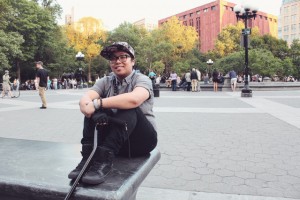 I think that there is a level of accountability that happens as a writer, because inevitably you are a witness. So much comes into play as a witness and it takes a certain level of integrity that makes specific art cultural work, political work, activist work. I write for and by. I don’t play like I am anything else than what I have experienced and how I have been impacted. This question always stumps me, because how can one separate the social, cultural, and political impacts of art? Art is central to social change. Art has been the archive, the action plan, and the mapping for many political movements. From protest theatre of the Philippines to ciphers spitting on corners of city streets, to the love songs we write for each other, we learn to survive by the very ways we create.
I think that there is a level of accountability that happens as a writer, because inevitably you are a witness. So much comes into play as a witness and it takes a certain level of integrity that makes specific art cultural work, political work, activist work. I write for and by. I don’t play like I am anything else than what I have experienced and how I have been impacted. This question always stumps me, because how can one separate the social, cultural, and political impacts of art? Art is central to social change. Art has been the archive, the action plan, and the mapping for many political movements. From protest theatre of the Philippines to ciphers spitting on corners of city streets, to the love songs we write for each other, we learn to survive by the very ways we create.
Art also takes ritual, a deliberate force, an investment, and energy that reflects the temperature of the times we live in. Ritual and repetition are political acts. We create patterns of political existence that not only keep us alive, but keep us aware of our own complexities and power. How many trans brown bois who grew up poor and with disabilities are out there? I am writing to every single one. I’m writing over and over until it builds the numbers we’re told are invisible. If any of those demographics belong to you, I must find you. I haven’t been able to make distinctions between art and activism out of the very urgency that impacts myself, my communities. I’ve been in collectives and facing struggle in multiple ways, so my leisure for art for art’s sake feels like a violent attempt [at] erasure. My work isn’t about collecting social constructs or artifacts so much as it is [about] examining them, calling them into confession, seeking guides to live by, releasing the trauma, an investigation and an affirmation. These are my goals at least. No pressure!
Do you have any forthcoming projects you’d like to mention?
I am currently working on a poetry manuscript and have been accepted by an exciting new and innovative publisher. I am pleased with the love and grit it is taking me. Most recently, I had the pleasure of facilitating a workshop with fat justice activist & healer Geleni Fontaine for INCITE’s Color Of Violence 4 Conference on healing & cultural work, called “Liberation Shows Up!” We were thrilled to welcome over 150+ participants, all Sick, Disabled, Queer & Trans People of Colour. This workshop is now a curriculum that I tour and facilitate nationwide. I am doing keynote speeches for various queer people of colour and social justice conferences in the US. I’ve recently been published in an anthology and zine published by Topside Press called Trans Poets Will Burn Your House Down from the Trans Poets Workshop NYC. Additionally, I am in collaboration with the Tangled Art + Disability Artist-in-Residence on a Transformative Grief Project with Toronto poet & stunner mel g. campbell.
Rachna Contractor writes about art, community and social change. Her work has been published in Xtra, Kala Quarterly and Wiqaable.

